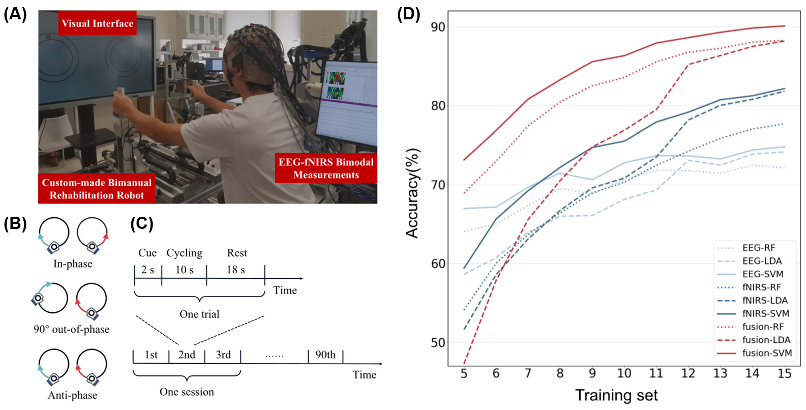Our Ph.D. candidate Yichuan Jiang proposed a unified EEG-fNIRS bimodal signal processing framework to characterize neural activities-induced by robot-assisted bimanual training in IEEE Transactions on Neural Systems and Rehabilitation Engineering (IF = 3.802).
Bimanual tasks that involve upper limbs working in a highly coordinated way are prevalent in daily activities. However, for hemiparetic stroke patients, the inefficient control of the infected upper limb may cause difficulty in performing bimanual tasks, leading to loss of life independence. Robot-assisted bimanual training is promising to improve motor function and cortical reorganization. Closing the rehabilitation training loop with neurofeedback can help refine training protocols in time for better engagements and outcomes. However, due to the low signal-to-noise ratio (SNR) and non-stationary properties of neural signals, reliable characterization of bimanual training-induced neural activities from single-trial measurement is challenging.

In this study, ten human participants were recruited conducting robot-assisted bimanual cyclical tasks (in-phase, 90◦ out-of-phase, and anti-phase) when concurrent electroencephalography (EEG) and functional near-infrared spectroscopy (fNIRS) were recorded. A unified EEG-fNIRS bimodal signal processing framework was proposed to characterize neural activities induced by three types of bimanual cyclical tasks. In this framework, novel artifact removal methods were used to improve the SNR and the task-related component analysis (TRCA) was introduced to increase the reproducibility of EEG-fNIRS bimodal features. The optimized features were transformed into lowdimensional indicators to reliably characterize bimanual training-induced neural activation. The SVM classification results of three bimanual cyclical tasks revealed a good discrimination ability of EEG-fNIRS bimodal indicators (90.1%), which was higher than that using EEG (74.8%) or fNIRS (82.2%) alone, supporting the proposed method as a feasible technique to characterize neural activities during robot-assisted bimanual training.
Yichuan Jiang, a Ph.D. candidate of Southern University of Science and Technology, is the first author of this article. Mingming Zhang, assistant professor of Southern University of Science and Technology, is the corresponding author of this article. Southern University of Science and Technology is the first unit and communication unit.
